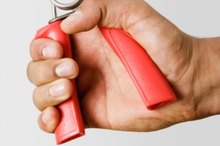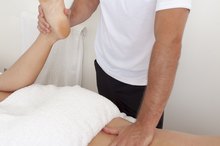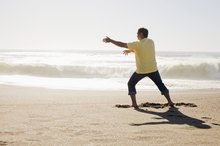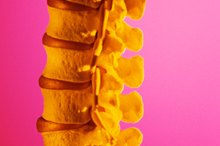What does fact checked mean?
At Healthfully, we strive to deliver objective content that is accurate and up-to-date. Our team periodically reviews articles in order to ensure content quality. The sources cited below consist of evidence from peer-reviewed journals, prominent medical organizations, academic associations, and government data.
The information contained on this site is for informational purposes only, and should not be used as a substitute for the advice of a professional health care provider. Please check with the appropriate physician regarding health questions and concerns. Although we strive to deliver accurate and up-to-date information, no guarantee to that effect is made.
Exercise Ball for Sciatica Relief
The sciatic nerve begins in your lower back and runs down your leg. When this nerve becomes pinched, you experience pain, numbness or tingling. To alleviate this pain and reduce nerve inflammation, you can use an exercise ball, a common physical therapy tool 3. With frequent and consistent exercise, you can experience relief.
Causes
A degenerative condition or injury can result in sciatica. Degenerative conditions include lumbar spinal stenosis or spondylolisthesis, where a vertebra slips out of place due to disk degeneration, according to Medline Plus 1. Trauma such as a car accident or hit to the lower back also can lead to sciatica. Your physician can diagnose this condition via a physical exam and imaging tests. He may recommend conservative treatments, such as ice and physical therapy using an exercise ball can help reduce symptoms.
- A degenerative condition or injury can result in sciatica.
- He may recommend conservative treatments, such as ice and physical therapy using an exercise ball can help reduce symptoms.
Benefits
Tennis Ball Exercises to Relieve Tight Paraspinals
Learn More
An exercise ball is a beneficial tool for sciatica relief because of its ability to work your back muscles, often without you knowing it, according to Spine-Health 23. Sitting or lying on the exercise ball creates an element of instability, which requires spinal and abdominal muscles to contract to stabilize the body. Strengthening these muscles can reduce your sciatica pain. Because exercising with the ball promotes a neutral spine position, this can help you to maintain proper form when performing sciatica exercises 2.
Seated Exercise
This exercise from Spine-Health aims to open the spinal canal where the sciatic nerve lies and to strengthen the back muscles 3. Begin by sitting on the ball and placing your hands on your hips. Slowly pull your pelvis toward your belly button to feel a stretch in the lower back. Return your hips to your starting position, then reverse the exercise by arching the back. Return the hips to neutral position. Repeat the entire sequence for a total of 10 repetitions.
- This exercise from Spine-Health aims to open the spinal canal where the sciatic nerve lies and to strengthen the back muscles 3.
- Return your hips to your starting position, then reverse the exercise by arching the back.
Stretching Exercise
Physical Therapy Exercises After Hand Surgery
Learn More
To perform this exercise from Spine-Health, begin kneeling with your hands on the exercise ball 3. Move your hands away from the body to roll the exercise ball away and move your body forward. Keep your back as straight as possible and your head aligned with your body. Roll the ball to the right side, then the left. Return to your starting position, then perform five additional repetitions.
- To perform this exercise from Spine-Health, begin kneeling with your hands on the exercise ball 3.
- Move your hands away from the body to roll the exercise ball away and move your body forward.
Misconception
While sciatica pain may leave you wishing to stay in bed to rest, doing so can hinder your recovery, according to Spine-Health 2. While resting one to two days after your pain flares up can help, inactivity beyond this time frame can weaken your back. Instead, engage in exercise ball exercises and other movements that help to strengthen the back and stimulate spinal fluid to the spinal discs.
Related Articles
References
- Medline Plus: Sciatica
- Spine-Health: Sciatica Exercises for Sciatica Pain Relief
- Spine-Health: Exercise Ball Therapy for Low Back Pain Relief
- American Academy of Orthopaedic Surgeons: Low Back Pain Exercise Guide
- Davis D, Maini K, Vasudevan A. Sciatica. [Updated 2020 Jan 25]. In: StatPearls [Internet]. Treasure Island (FL): StatPearls Publishing; 2020 Jan-. Available from: https://www.ncbi.nlm.nih.gov/books/NBK507908/
- Giuffre BA, Jeanmonod R. Anatomy, Sciatic Nerve. [Updated 2020 Mar 11]. In: StatPearls [Internet]. Treasure Island (FL): StatPearls Publishing; 2020 Jan-. Available from: https://www.ncbi.nlm.nih.gov/books/NBK482431/
- National Institute of Neurological Disorders and Stroke. Low Back Pain Fact Sheet. Updated August 13, 2019. ninds.nih.gov
- Verwoerd AJH, Mens J, El Barzouhi A, Peul WC, Koes BW, Verhagen AP. A diagnostic study in patients with sciatica establishing the importance of localization of worsening of pain during coughing, sneezing and straining to assess nerve root compression on MRI. Eur Spine J. 2016;25(5):1389–1392. doi:10.1007/s00586-016-4393-8
- Koes BW, van Tulder MW, Peul WC. Diagnosis and treatment of sciatica. BMJ. 2007;334(7607):1313–1317. doi:10.1136/bmj.39223.428495.BE
- Chen MR, Wang P, Cheng G, Guo X, Wei GW, Cheng XH. The warming acupuncture for treatment of sciatica in 30 cases. Journal of Traditional Chinese Medicine 2009 29(1):50-3.
- Lawrence DJ, Meeker W, Branson R, Bronfort G, Cates JR, Haas M, Haneline M, Micozzi M, Updyke W, Mootz R, Triano JJ, Hawk C. Chiropractic management of low back pain and low back-related leg complaints: a literature synthesis. Journal of Manipulative and Physiological Therapeutics 2008 31(9):659-74. doi:10.1016/j.jmpt.2008.10.007
- Bell J. Massage therapy helps to increase range of motion, decrease pain and assist in healing a client with low back pain and sciatica symptoms. Journal of Bodywork and Movement Therapies 2008 12(3):281-9. doi:10.1016/j.jbmt.2008.01.006
Writer Bio
Rachel Nall began writing in 2003. She is a former managing editor for custom health publications, including physician journals. She has written for The Associated Press and "Jezebel," "Charleston," "Chatter" and "Reach" magazines. Nall is currently pursuing her Bachelor of Science in Nursing at the University of Tennessee.









